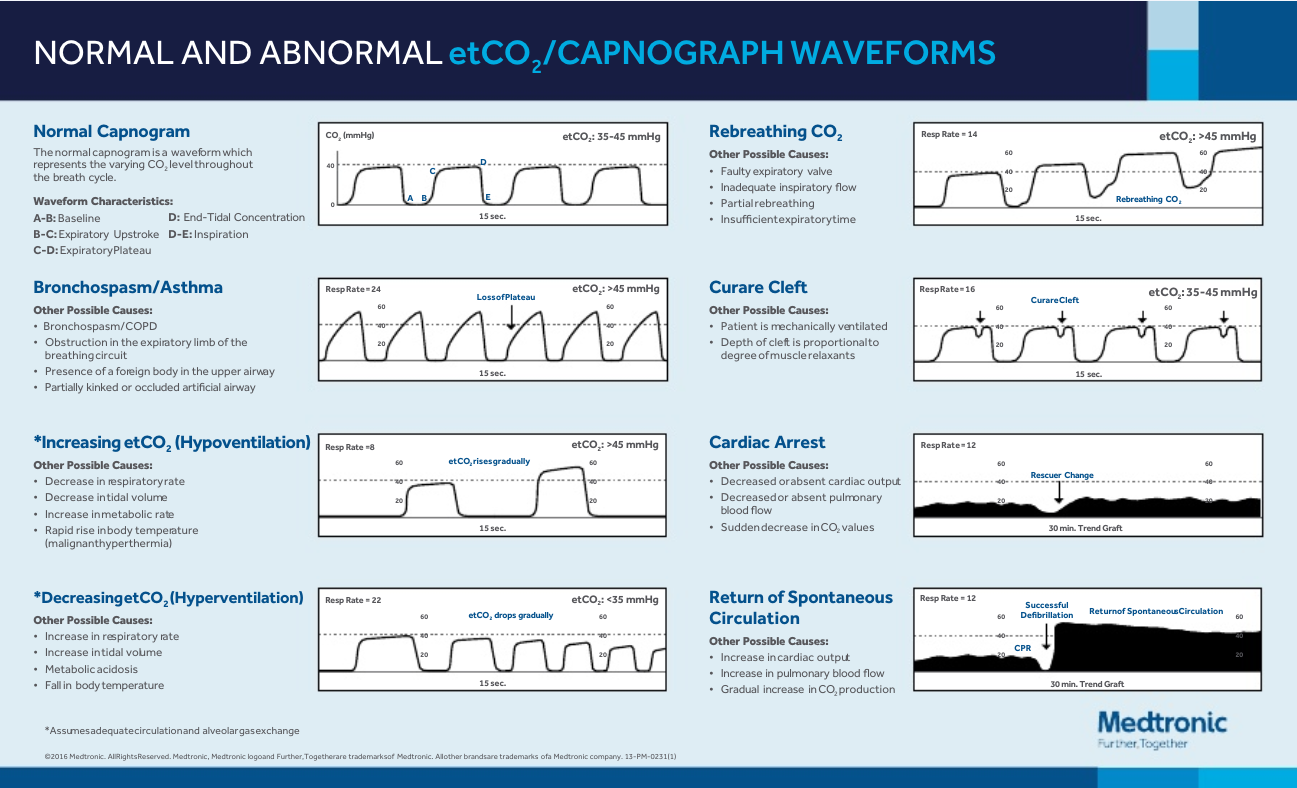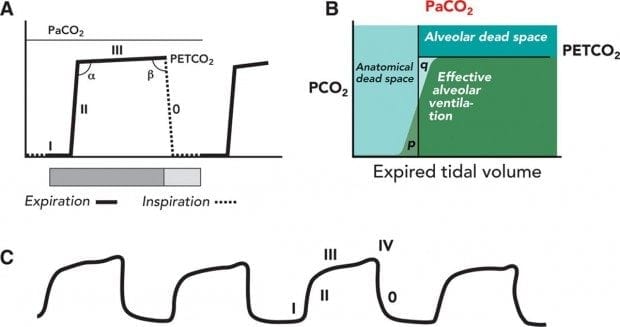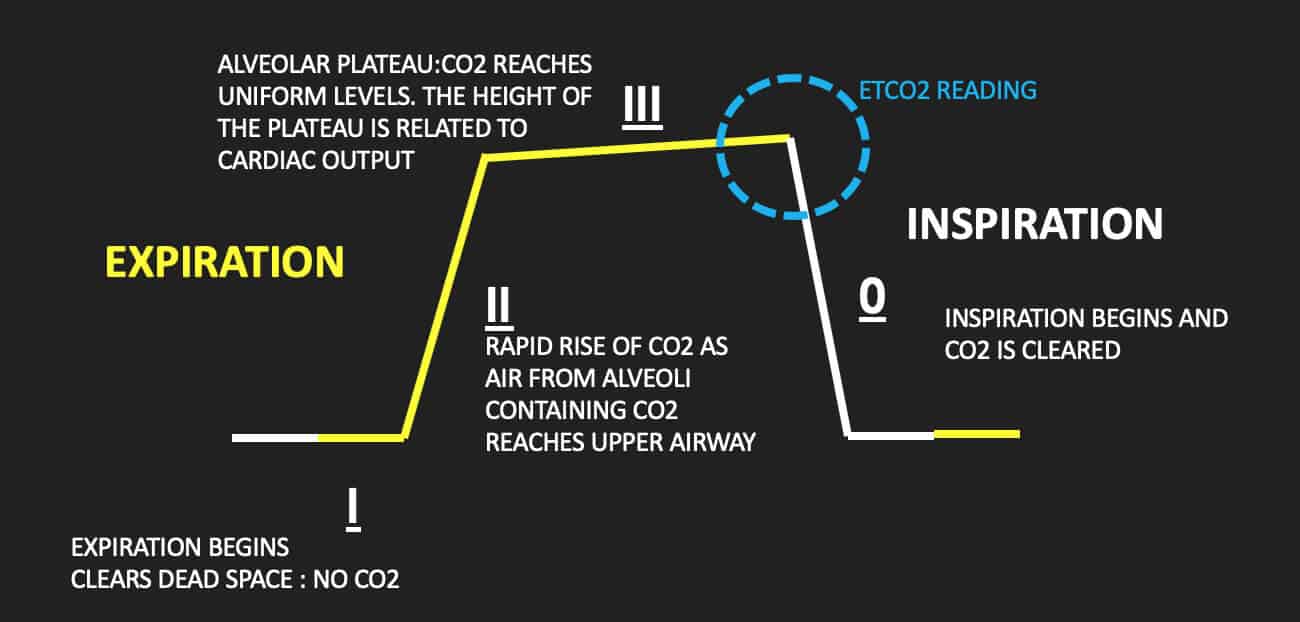end tidal co2 meaning
End-tidal carbon dioxide EtCO 2 waveform monitoring allows you to measure all three. Low EtCO 2 with other signs of shock indicates poor systemic perfusion which can be caused by hypovolemia sepsis or dysrhythmias.

Normal And Abnormal Capnography Waveforms Infographic Capnoacademy Capnoacademy
End-tidal CO 2 monitoring has also been useful for breathing retraining as it provides additional information about the progress of a persons breathing normalization.
. End-tidal carbon dioxide ETCO2 is the level of carbon dioxide that is released at the end of an exhaled breath. This is a major respiratory symptom. Utilizing End-Tidal Carbon Dioxide to Diagnose Diabetic Ketoacidosis in Prehospital Patients with Hyperglycemia.
Definition of Low CO2 hypocapnia Hypocapnia hypocapnea also known as hypocarbia is defined as a deficiency of carbon dioxide in the arterial blood. The Area Under the Receiver Operating. Monitoring end-tidal CO 2 ET-CO 2 provides instantaneous information about ventilation how effectively CO 2 gas is being exhaledeliminated by the respiratory system perfusion how effectively CO 2 is being transported through the vascular system to the lungs and metabolism how effectively CO 2 is being produced by cellular metabolism.
Carbon dioxide through the respiratory cycle Measuring of End tidal CO2 is considered a standard of care for confirming endotracheal tube placement An important adjunct for assessing a critical patient The Journey of A Molecule Through the Respiratory Cycle. End-tidal CO2 EtCO2 monitoring is a noninvasive technique which measures the partial pressure or maximal concentration of carbon dioxide CO2 at the end of an exhaled breath which is expressed as a percentage of CO2 or mmHg. 1 ACLS guidelines define high quality chest compressions as.
ETCO2 emergency department monitoring and critical. To study the value of end-tidal carbon dioxide EtCO2 measurement during pediatric and adult endoscopic procedures with the patient under general anesthesia GA and conscious sedation. 5 were diagnosed with DKA.
The amount of CO2 at the end of exhalation or end-tidal CO2 ETCO2 is normally 35-45. Sometimes however etCO 2 monitoring is used as a feedback or biofeedback mechanism. CO2 is a byproduct of cellular metabolism which gets transported in the blood to the lungs for elimination.
Carbon dioxide CO 2 is a product of metabolism transported via perfusion and expelled through ventilation. In the awake adult normal cardiac index lies between 25-4 Lminm2 with an ETCO2 of 35-45 mmHg. When the measurement is taken at the end of a breath exhaling it is called end tidal CO 2 ETCO 2.
MONITORING of end-tidal carbon dioxide is one of the most important means of determining the physiologic well-being of anesthetized patients. In this study the aim was to review the applications of end-tidal carbon dioxide ETCO2 monitoring in emergency department multiple databases were comprehensively searched with combination of following keywords. End-tidal carbon dioxide monitoring ETCO2 has clinical uses far beyond solely determining hypo- or hyperventilation.
The arterial CO2 value for normal breathing at rest is 40 mm. The normal values are 5 to 6 CO2 which is equivalent to 35-45 mmHg. Eisenberg and Terry J.
Exhaled carbon dioxide both in terms of its quantity and pattern provides detailed information on the cardiopulmonary system. Medical Definition of end-tidal. End tidal carbon dioxide concentration.
Mengert The New England Journal. On average during CPR if adequate chest compressions are being delivered a cardiac index of 16-19 Lminm2 can be generated which correlates with ETCO2 pressures of 20mmHg. Citation needed The capnogram is a direct monitor of the inhaled and exhaled concentration or partial pressure of CO 2 and an indirect monitor of the CO 2 partial pressure in the arterial blood.
Capnograph is an indispensable tool for monitoring metabolic and respiratory function. It is the measurement of CO2 at the completion of exhalation and roughly correlates to the CO2 present in arterial blood. Of or relating to the last portion of expired tidal air End-tidal carbon dioxide monitors are already being used and are recommended to indicate the adequacy of cardiopulmonary resuscitation and the likelihood of a successful resuscitation.
Most medical sources define hypocapnia as less than 35 mm Hg for partial CO2 pressure in the arterial blood. This non-invasive monitor can give valuable information about cardiac output perfusion and ventilation. In critical care End Tidal CO 2 monitoring is used to assess adequacy of circulation to the lungs which provides clues about circulation to the rest of the body.
The mean level of ETCO2 in those without DKA was 35mmHg 95 CI 33-38mmHg compared to mean levels of 15mmHg 95 CI 8-21mmHg in those with DKA P. ETCO2 levels reflect the adequacy with which carbon dioxide CO2 is carried in the blood back to the lungs and exhaled. When the spontaneous breathing of the patients started their respirations were supported as the end-tidal carbon dioxide ETC Osub2 value would be 35-40 mmHg.
End-tidal capnography or end-tidal CO2 EtCO2 monitoring is a non-invasive technique that measures the partial pressure or maximal concentration of carbon dioxide CO2 at the end of an exhaled breath. Pulse oximetry has become the standard of care during endoscopic procedures despite the fact that significant alveolar hypoventilation may be undetected.

Waveform Capnography In The Intubated Patient Emcrit Project

Average Etco2 Kpa During Cpr In Patients With Or Without Rosc Download Scientific Diagram

Quantitative Waveform Capnography Acls Medical Training
The Normal Capnograph Waveform Deranged Physiology

Exhaled Carbon Monoxide End Tidal Co2 And Peripheral Oxygen Saturation Download Table

The Impact Of Ventilation Rate On End Tidal Carbon Dioxide Level During Manual Cardiopulmonary Resuscitation Resuscitation

Basic Capnography Interpretation Nuem Blog
Emdocs Net Emergency Medicine Educationcapnography In The Ed Emdocs Net Emergency Medicine Education
Riding The Wave Of Capnography Understanding Etco2 Vetbloom Blog
End Tidal Co2 The Drummer Of The Vital Sign Band Pem4

Capnography Waveform Interpretation Litfl Ccc Equipment

End Tidal Carbon Dioxide Recording Of Ventilated Children In Picu N 535 Download Scientific Diagram

Etco2 Valuable Vital Sign To Assess Perfusion The Airway Jedi

Basic Capnography Interpretation Nuem Blog
Etco2 End Tidal Co2 By Acronymsandslang Com
End Tidal Co2 Monitoring In The Pre Hospital Environment More Than Just Endotracheal Tube Placement Confirmation Journal Of Paramedic Practice

Waveform Capnography In The Intubated Patient Emcrit Project

